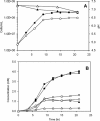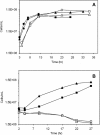Efficient degradation of lignocellulosic plant biomass, without pretreatment, by the thermophilic anaerobe "Anaerocellum thermophilum" DSM 6725
- PMID: 19465524
- PMCID: PMC2708433
- DOI: 10.1128/AEM.00236-09
Efficient degradation of lignocellulosic plant biomass, without pretreatment, by the thermophilic anaerobe "Anaerocellum thermophilum" DSM 6725
Abstract
Very few cultivated microorganisms can degrade lignocellulosic biomass without chemical pretreatment. We show here that "Anaerocellum thermophilum" DSM 6725, an anaerobic bacterium that grows optimally at 75 degrees C, efficiently utilizes various types of untreated plant biomass, as well as crystalline cellulose and xylan. These include hardwoods such as poplar, low-lignin grasses such as napier and Bermuda grasses, and high-lignin grasses such as switchgrass. The organism did not utilize only the soluble fraction of the untreated biomass, since insoluble plant biomass (as well as cellulose and xylan) obtained after washing at 75 degrees C for 18 h also served as a growth substrate. The predominant end products from all growth substrates were hydrogen, acetate, and lactate. Glucose and cellobiose (on crystalline cellulose) and xylose and xylobiose (on xylan) also accumulated in the growth media during growth on the defined substrates but not during growth on the plant biomass. A. thermophilum DSM 6725 grew well on first- and second-spent biomass derived from poplar and switchgrass, where spent biomass is defined as the insoluble growth substrate recovered after the organism has reached late stationary phase. No evidence was found for the direct attachment of A. thermophilum DSM 6725 to the plant biomass. This organism differs from the closely related strain A. thermophilum Z-1320 in its ability to grow on xylose and pectin. Caldicellulosiruptor saccharolyticus DSM 8903 (optimum growth temperature, 70 degrees C), a close relative of A. thermophilum DSM 6725, grew well on switchgrass but not on poplar, indicating a significant difference in the biomass-degrading abilities of these two otherwise very similar organisms.
Figures






References
-
- Andersson, S., H. Wikberg, E. Pesonen, S. L. Maunu, and R. Serimaa. 2004. Studies of crystallinity of Scots pine and Norway spruce cellulose. Trees 18:346-353.
-
- Bastawde, K. B. 1992. Xylan structure, microbial xylanases, and their mode of action. World J. Microbiol. Biotechnol. 8:353-368. - PubMed
-
- Bayer, E. A., L. J. Shimon, Y. Shoham, and R. Lamed. 1998. Cellulosomes—structure and ultrastructure. J. Struct. Biol. 124:221-234. - PubMed
-
- Blumer-Schuette, S. E., I. Kataeva, J. Westpheling, M. W. Adams, and R. M. Kelly. 2008. Extremely thermophilic microorganisms for biomass conversion: status and prospects. Curr. Opin. Biotechnol. 19:210-217. - PubMed
-
- Chen, S. F., R. A. Mowery, C. J. Scarlata, and C. K. Chambliss. 2007. Compositional analysis of water-soluble materials in corn stover. J. Agric. Food Chem. 55:5912-5918. - PubMed
Publication types
MeSH terms
Substances
LinkOut - more resources
Full Text Sources
Other Literature Sources
Molecular Biology Databases

